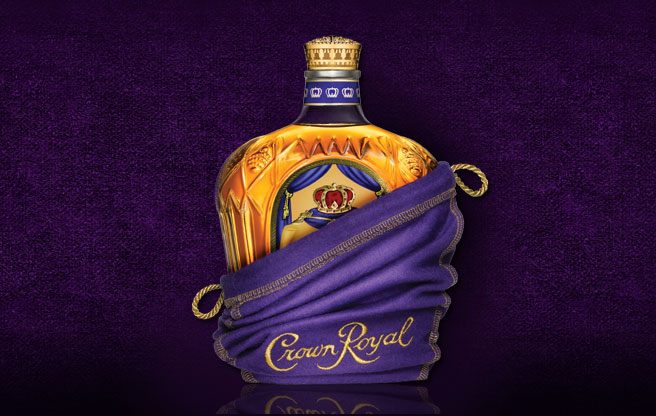
Canadian Whisky
My father was a martini man to the core (vodka, with two cocktail olives), but I trace my fondness for Canadian whisky directly to him. You see, he loved to play Scrabble, and in his retirement years he was able to indulge this passion — sometimes it verged on addiction — as if there were no tomorrow. On my frequent visits to his place in Florida in the 1990s, we sometimes played a dozen games or more a day, punctuated generally by lunch, dinner, and, frequently, a visit from Dad’s best friend, Ernie, an estimable competitor who liked to squeeze in a game or two between his afternoon errands.
But back to the Canadian whisky. Rather than spreading all the tiles out upside-down on the table, as some Scrabble players do, Dad liked to keep them in a little drawstring pouch made of deep-purple cloth and embroidered with the logo of Crown Royal. This, it turned out, was exactly the right tool for the job (permitting, as it did, a vigorous shake between draws), but with time and heavy use the bag came to look threadbare and rather forlorn. And so I started buying a bottle of Crown Royal every now and then for the purpose of presenting my Dad with a brand-new Scrabble pouch every time I visited in Florida.
Thus began my long and rewarding acquaintanceship with Canadian whisky, the kindest and gentlest of all the world’s whiskies. (Like Scotch, Canadian whisky is spelled without the ‘e.’) There is something lusciously smooth and silky about a good Canadian whisky, and the better ones have that creamy, butter-toffee sweetness that makes such a memorable impression on the way down and for a while afterward. And whatever you may have heard or been told, Canadian whisky isn’t only for inexperienced or unadventurous palates. Despite its generally light taste and appearance, Canadian whisky can have plenty of character and style.
A few basics. By definition, Canadian whisky is grain spirit that has been aged in charred oak barrels for at least three years. Virtually all Canadian whiskies are blended from different grain whiskies of different ages (the pot-distilled malt whisky of Glenora, in Nova Scotia, is the notable exception); the base whisky is almost always from corn, with an addition of rye, wheat, barley, or barley malt. (As a rule, the spicier the aroma of a Canadian whisky, the larger the component of rye in the blend.) Most Canadian whiskies fall in the four- to six-year-old range. Under Canadian law, Canadian whisky may contain up to 9.09 percent of something else; for some distillers that means a dash of Kentucky bourbon, for others it means the deployment of such flavoring agents as sherry, or, worse yet, distilled orange juice.
The dominance of Canadian whisky in the U.S. marketplace can be traced directly to Prohibition. Most Americans don’t realize that Canada went dry on a national level first, in March 1918, but from the beginning its experiment proved to be unpopular, unenforceable, and otherwise untenable. Prohibition in Canada was gone by November 1919, but the United States did not learn from its neighbor to the north. At midnight on January 16, 1920, the manufacture, sale, and consumption of alcohol — except for “medicinal purposes” — became illegal throughout the United States. Almost overnight, a case of Canadian whisky that sold for $10 in Montreal fetched about $80 in Manhattan. Little wonder that, during the ensuing dry period in U.S. history, so many millions of gallons of Canadian whisky washed across the border into the nation’s illicit speakeasies.
By 1924, according to the U.S. Coast Guard, two-thirds of the whisky being brought into the United States was of Canadian origin. Canadian whisky—a good bit of it from the Waterloo distillery of Joseph E. Seagram & Sons, Ltd. — had become synonymous with quality; this was “the good stuff” — the very antithesis of moonshine and bathtub gin. In 1928, Samuel and Harry Bronfman, who just ten years earlier had been selling liquor by mail (the only legal way during Canadian Prohibition), purchased Seagram & Sons, amalgamated it with their own company, Distillers Corporation Limited, and went public. Then, anticipating the end of Prohibition in the United States, they began warehousing whisky. When “The Big Thirst” finally ended in 1933, the Bronfmans had the world’s largest stockpile of aged (and thus ready-for-market) whiskies.
In 1939, reportedly after blending some six hundred whisky samples, Sam Bronfman introduced Crown Royal to commemorate the historic visit of King George VI and Queen Elizabeth to Canada. Some sixty-odd years later, this is a whisky still worth savoring from nose to palate to finish. “If I had to pick a single whisky from the Seagram stable of thoroughbreds as the finest of all,” Jim Murray, the dean of the world’s whisky writers, wrote not so long ago, “perhaps surprisingly it would be the ordinary Crown Royal.”
I’ll drink to that — maybe even over a game of Scrabble.
This article originally appeared in the September 2001 issue of The American Mix.
